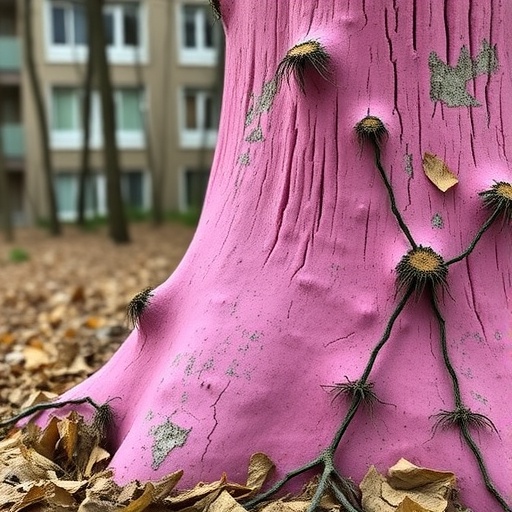The accelerating pace of climate warming, particularly acute in mountainous regions such as the Alps, presents multifaceted challenges for native organisms. Adapting to rising temperatures or migrating to higher altitudes represent the primary survival strategies available to alpine flora. Failure to do either results in population decline and possible extinction. A recent study led by Simone Fior and Alex Widmer at the Institute of Integrative Biology, ETH Zurich, provides a compelling case study of evolutionary adaptation mechanisms in Dianthus sylvestris, commonly known as the wood pink, a perennial species that inhabits altitudes ranging from 800 to 2,400 meters in the Swiss Alps.
Several striking phenological differences characterize the wood pink populations from lowland valleys versus alpine high elevations. Chief among these is the shift in flowering time. At high altitudes, wood pinks bloom immediately following snowmelt in early June, optimizing the short growth season at these elevations. In contrast, populations in warmer valley environments initiate flowering later, despite the growing season there commencing earlier in the spring. This counterintuitive late blooming in the valleys appears to be an evolutionary adaptation preventing premature flowering in more temperate microclimates.
The ETH Zurich team conducted genetic and ecological investigations on three populations from Alpine valleys and three from mountainous areas within the canton of Valais. They sequenced a key gene variant in 1,000 individuals across the wood pink’s distribution and executed reciprocal transplantation experiments to discern if flowering behavior was plastic or genetically fixed. These comprehensive approaches revealed that high-altitude wood pinks flower rapidly post-snowmelt and expedite seed production, maximizing reproductive success within a compressed growing window. Valley plants, endowed with more extended favorable conditions, allocate additional time to vegetative growth and delayed flowering.
Intriguingly, transplantation results demonstrated that when valley wood pinks were moved to mountain sites, their flowering remained delayed relative to native alpine populations. These specimens persisted in extended vegetative development, producing numerous flowers and seeds too immature for dispersal before early snowfalls. This differential phenology implicates genetic control as the primary determinant of flowering timing rather than environmental cues alone. The gene identified as DsCEN/2 emerged from this study as the critical regulator of this divergent phenology, harboring two allelic variants that segregate according to elevation: the “warm” allele predominates in valley populations while the “cold” allele is found chiefly in alpine groups.
Functionally, the warm allele promotes delayed flowering alongside substantial vegetative growth, advantageous in longer, warmer seasons typical of valley habitats. Conversely, the cold allele triggers immediate post-snowmelt flowering coupled with rapid seed formation, essential for survival in the abbreviated growing period of high altitudes. Consequently, these allele variants constitute genetic modules fine-tuned to distinct climate zones, optimizing the species’ fitness under contrasting environmental regimes.
Evolutionary models suggested that these alleles’ origins predate the wood pink species itself by millions of years. Comparative genomic analyses involving related Dianthus species unveiled that these two pivotal alleles existed in the broader genus prior to Dianthus sylvestris speciation. Approximately one to two million years ago, the Dianthus genus underwent a radiation event marked by the swift diversification of one ancestral species into multiple descendants, coinciding with repeated glacial-interglacial climate oscillations. These environmental fluxes likely drove natural selection favoring allelic diversity pertaining to flowering phenology.
Genetic mechanisms such as recombination during sexual reproduction reshuffled ancient allelic variants, ultimately embedding both warm and cold alleles into the wood pink genome. This integration of long-standing gene variants enables the species to adapt more rapidly to novel environmental conditions than would be possible through de novo mutations alone. Such a process enhancing adaptive potential by recombining pre-existing genetic diversity is especially pronounced within radiating taxa, providing a robust framework for ecological versatility.
Notably, despite ongoing mutations throughout wood pink populations, the foundational allelic variation controlling flowering timing has been remarkably stable over hundreds of thousands of years. This conservation underscores the alleles’ adaptive value and represents an evolutionary reservoir conferring resilience to climatic fluctuations beyond recent epochs.
Looking ahead, the study proposes that these ancient gene variants may mediate wood pink responses to contemporary and future climate warming. Data reveal that the warm allele is already spreading into high-elevation populations, setting the stage for potential elevation shifts in flowering behavior corresponding with rising temperatures. This pre-existing genetic toolkit thus equips the wood pink with intrinsic capacity to genetically buffer against rapid environmental transformations.
Nevertheless, the unprecedented speed of current global warming poses a daunting challenge. Whether alpine plants like the wood pink can adjust genetically swiftly enough to keep pace with anthropogenic climate change remains unknown. Research gaps persist regarding the adaptive potential of other high-mountain species under accelerated warming scenarios, with the wood pink study standing as one of the most rigorous examinations to date.
Crucially, the ability to harness standing genetic variation depends on population size and connectivity. Large, interbreeding populations maintain genetic diversity essential for evolutionary adaptation, while small or fragmented populations face heightened extinction risk due to limited genetic resources. Conservation efforts must consider these genetic and demographic factors to enhance species resilience amid ongoing climate perturbations.
This research illuminates the sophisticated interplay between evolutionary history and present-day adaptive capacity in alpine plants. The wood pink’s genetic legacy, shaped by millennia of climatic upheavals, embodies a potent example of how ancient allelic variation can drive phenotypic plasticity and ecological success across heterogeneous environments. As the climate crisis accelerates, unraveling such mechanisms will be pivotal for predicting the future of alpine biodiversity and guiding effective conservation strategies.
Subject of Research: Genetic adaptation mechanisms in alpine plant species, specifically Dianthus sylvestris (wood pink), in response to climate change.
Article Title: Genetic Legacy Facilitates Flowering Time Adaptation in Alpine Wood Pink Amidst Rapid Climate Warming
News Publication Date: Information not provided in source text.
Web References: http://dx.doi.org/10.1126/science.adp5717
References: Published study in the journal Science.
Keywords: Ecology, Climate change, Plant sciences, Genetics




